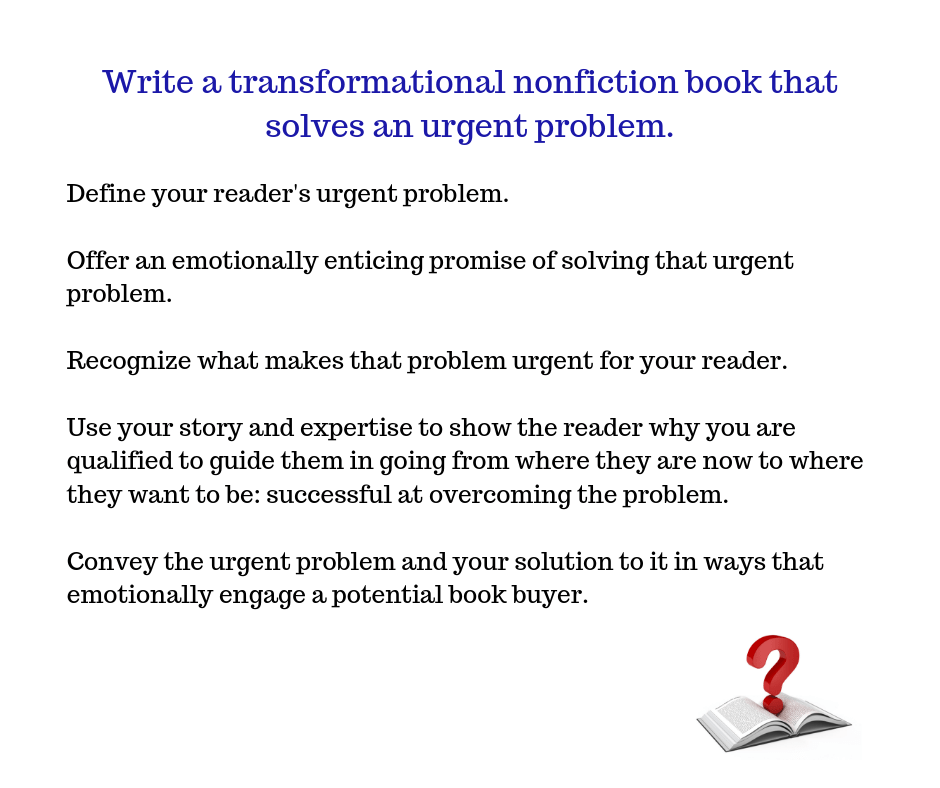WRITE A TRANSFORMATIONAL NONFICTION BOOK THAT SOLVES AN URGENT PROBLEM
Why should someone buy your transformational nonfiction book? Because you’re going to solve an urgent problem of theirs.
Back when I was an in-house editor at G. P. Putnam’s Sons and HarperCollins, I used to evaluate book proposals (selling tools used to try to get editors like me to give authors book deals). The book proposals for transformational nonfiction books—think business books, self-help, parenting, lessons on achieving success, and so on—had to make a compelling case that the book would solve an urgent problem for the reader.
When you write a transformational nonfiction book that solves an urgent problem for readers, you’re promising readers information and strategies. However, you also want them to feel they have to buy your book right now. It’s emotion that draws people in. Make your potential reader experience a sense of urgency about their problem and finding a solution that will end their headaches and frustration at last.
And keep this in mind: A reader’s urgent problem your book will solve might actually be a combination of problems.
My book, Raising a Sensory Smart Child, was written for the parent who wants to know how to help their child who has sensory processing issues. When I first began thinking of writing the book, there was information out there in bookstores and on the Internet but not enough for a parent like me to have a solid sense of what to do to get my child’s teeth brushed and to prevent him from melting down at the grocery store. Plenty of parents were stressed out and confused about what to do for their kids. My book would meet that urgent problem by offering even more information and strategies than they currently had. However, I knew that beyond needing those things, parents of kids with sensory processing issues are afraid that if their kids are struggling to function well (which is the case when kids with sensory issues don’t have them adequately addressed), kids are likely to become demoralized and give up on themselves. No parent wants that for their child, so I knew that addressing that particular fear was important. My co-author and I reassured potential readers with the promise that the book could help them go from being lost, confused, and worried (as I once was) to feeling competent and capable and actually helping their child manage their sensory issues (where I ended up after learning about sensory issues and developing “sensory smart” parenting strategies).
Problem and promise.
Both were infused with emotion.
My expertise was in going from where they were to where I was—an effective parent of a happy kid who, yeah, had sensory processing differences, but that’s okay and even a good thing in some ways.
The narrative arc of my story was emotionally compelling.
I wanted to make sure people believed and felt that if I could do it, they could, too.
Increase the emotional reassurance factor of your book, and you will have an easier time getting people to buy it.
Your narrative arc of going from your worst point to your greatest success increases the emotional factor of your book if you make your readers feel your fear, shame, and distress back when you were at your low point and feel the excitement of having reached your high point. Make them feel you empathize with their plight. That will help you attract readers who are in crisis or nearly frozen with anxiety about what will happen if they don’t fix their urgent problem.
If your readers have the problem you’ve identified, but you’re concerned it might not feel very urgent to them, you can increase the emotional impact of your book by warning them of what might happen if they don’t make a change now—they might end up where you did! Simultaneously, you can encourage them to believe they can get to where you are—success!—if only they read your book and use your strategies for addressing their problem. In sum, you can make their problem feel more urgent. And you can offer the tantalizing promise of solving it at last.
Effectively convey the urgent problem and your promise of helping them solve it.
Once you have identified your potential reader’s problem or problems, and you’ve offered a promise, you’ll need to make sure you clearly and effectively convey them. Use your title and subtitle combination, your book’s jacket, the short description of your book they’ll find on its back, and copy and images on your author website to get across the problem and promise. Also, spell out the urgent problem and your promise for solving it at the beginning of your book. Keep in mind, too, that you’re going to want your chapter titles to reflect the reader’s ability to go from where they are (having an urgent problem) to where they’re going to end up (problem solved or nearly so because they’re now better informed, have a clearer sense of what they need to do, and feel more confident). What’s the promise? What can they actually achieve? What will their journey from problem to promised outcome look like as they read your book?
As you try to identify the urgent problem or problems you reader has, consider the following:
How long has your reader had this problem? Is it ongoing and frustrating? Has the amount of stress the problem has caused them and is causing them enough to make them, well, pretty desperate for help now?
Does your reader feel he has tried everything? Has he become skeptical about whether the problem can be solved or at least addressed sufficiently that it no longer bothers him? Can she start believing there’s hope because of your inspiring story that led to your writing your book?
Have you anecdotes about working with people just like your reader who thought there was little hope for change, and who discovered that by using your ideas and strategies, they were able to achieve it after all?
What’s your reader willing to give up or do to make the urgent problem go away at last? Is he willing to commit to an action plan for change? Is she willing to question old ideas that have her stuck in a failure mindset?
The greater your reader’s frustration, the greater her urgency to finally find a solution. The greater the impact of the problem on your reader’s life, the more motivated she is to give your book a try.
Maybe you have the right action plan and approach that no one else has offered.
Maybe your personality, voice, and approach will make your book the game-changer for your reader because, unlike other books, your book gives them hope for the first time in a long time.
Maybe your hand-holding, compassionate way of talking about their problem will make them set aside their shame and embarrassment and tackle their problem at last.
Increasing the emotional impact of your book’s message will definitely give you a better shot at having your transformational nonfiction book sell. Even more than that, it will make your book more effective at helping readers to transform their lives for the better. Believe me, hearing from a reader that your book changed their life feels fantastic. THIS is why you’re writing your transformational nonfiction book!
Need help writing your business book, self-help book, life lessons book, or other transformational nonfiction book? Contact me and let me know what your expertise is, what type of book you have started to write, and what kind of help you feel you need.


Nancy Peske is a ghostwriter, developmental editor, and book publishing consultant who has done editorial work on books including bestsellers and award-winners for over 30 years.
[…] your audience’s problem. One aspect of defining your audience is clearly defining their problem that your book promises to solve. If they buy your book to solve a different problem, thinking you’ll address it, they’ll be […]